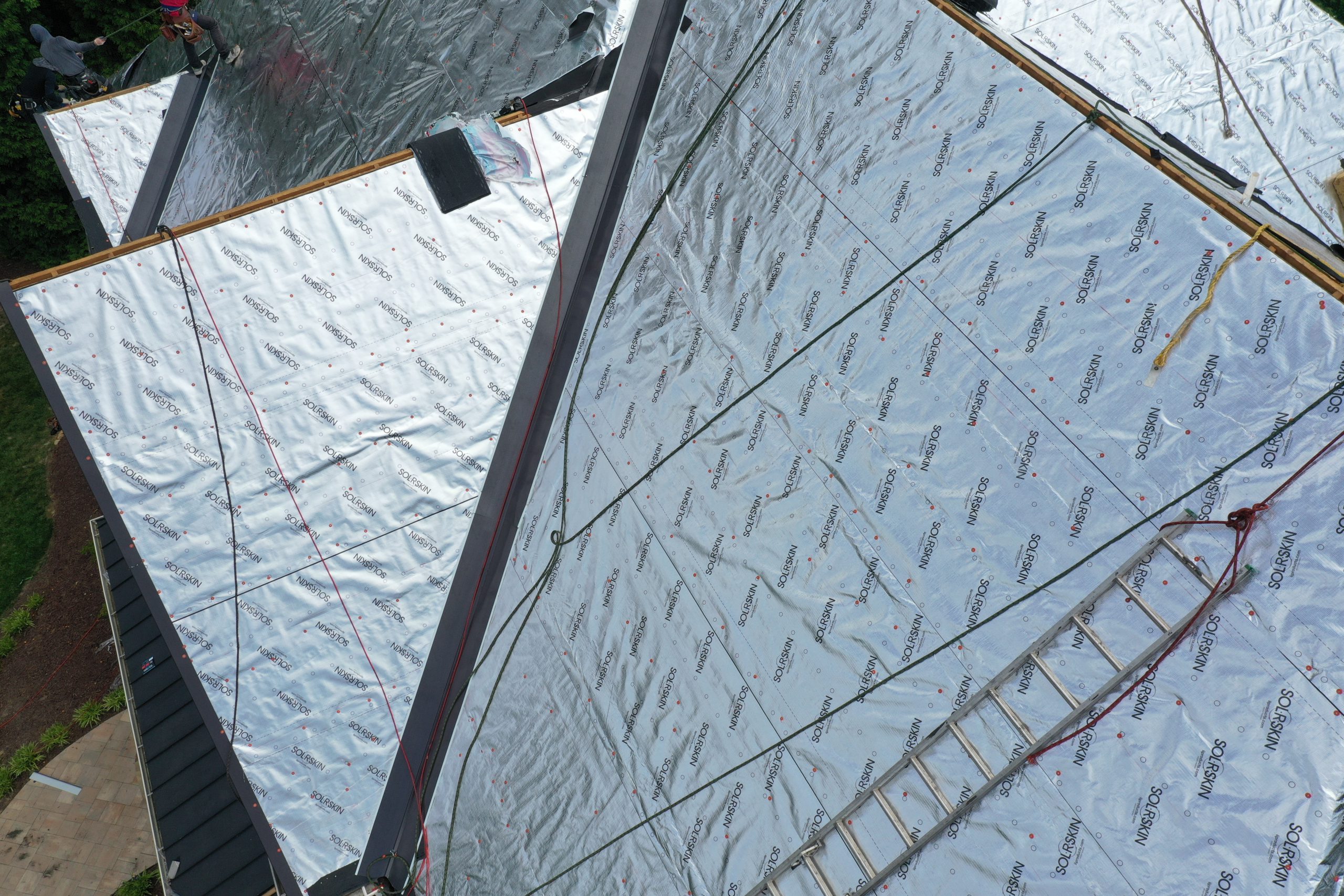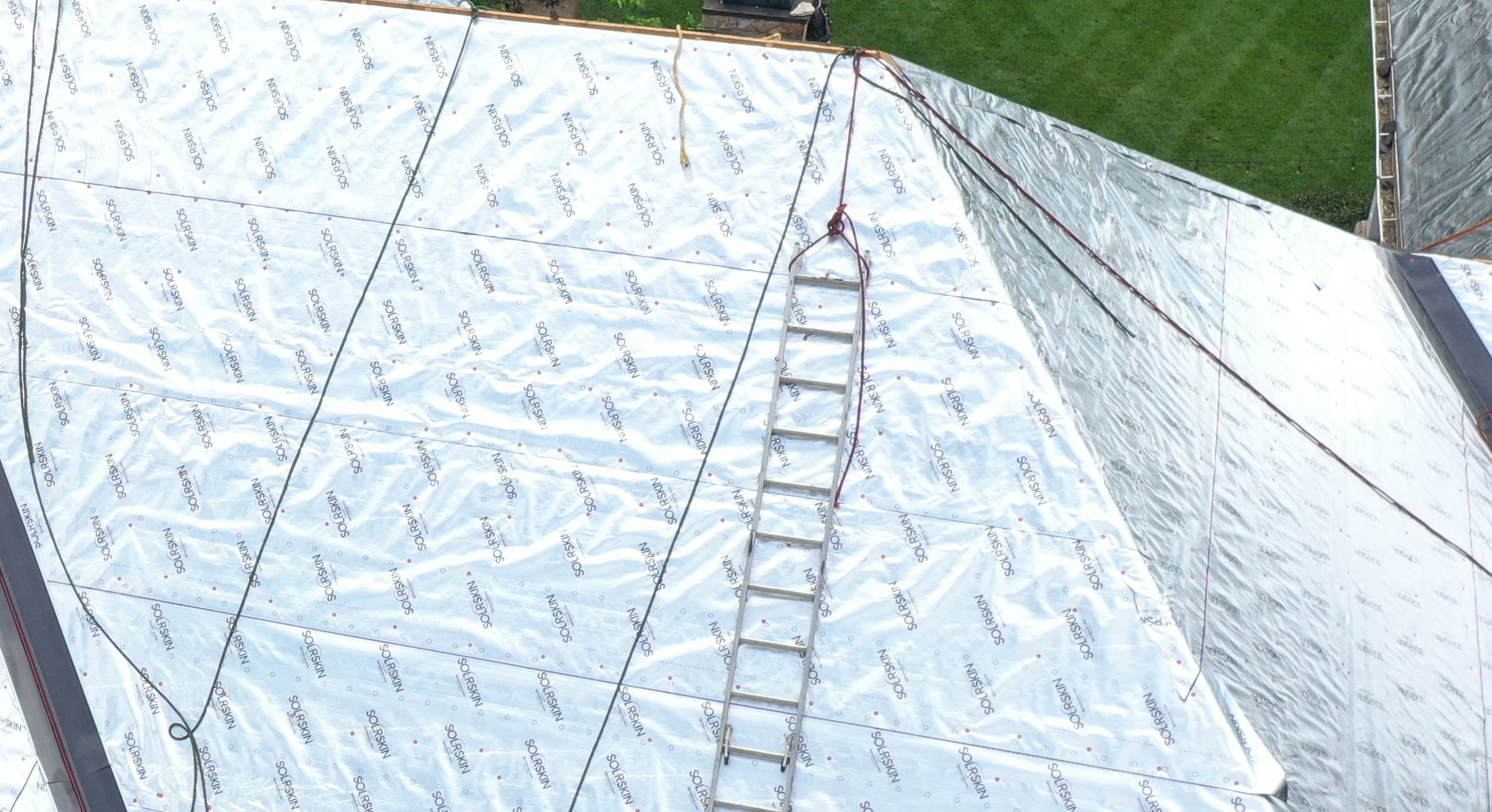
What is Sol-R-Skin
Sol-R-Skin is a new type of roofing underlayment that protects the roofing material over it, while protecting the structure under it. Sol-R-Skin uses a combination of polypropylene material, fiberglass, and aluminum to create what is considered the best roofing underlayment you can buy.
Most roofs include an underlayment made from petroleum products due to their resistance to water. Commonly called “tar paper” or “roofing felt”, this type of underlayment worked well in 1950, but not so much in today’s modern world of roofing. Tar paper tears easily, can be awkward to handle on a roof, and doesn’t do much but help prevent leaks.
Two of the most common issues with these petroleum based underlayments is that they offer essentially no insulative properties and they are extremely flammable. Sol-R-Skin was awarded a Class A thermal rating, which means it does a great job of reflecting most of the damaging effects of the sun.
Sol-R-Skin is to roofing products what electricity was to guitars. Sol-R-Skin does the typical job you would expect, which is to prevent leaks and make your roof last longer, but also cools your home and provides excellent resistance to fire.
Sol-R-Skin is to roofing products what electricity was to guitars. Sol-R-Skin does the typical job you would expect, which is to prevent leaks and make your roof last longer, but also cools your home and provides excellent resistance to fire.
Here we will briefly discuss what Sol-R-Skin does, how it does it, and why you might want it.
What Are the Signs I Need Sol-R-Skin for My Roof?
Sol-R-Skin roofing underlayment is installed whenever you are having your roof replaced. You simply replace the old, ineffective tar paper with a modern, advanced material. It is important to select the correct underlayment because roofs usually last a while, so whatever you install, you’re stuck with for a couple of decades.
An obvious sign your roof is deteriorating due to excessive heat and radiation are crumbling shingles. A fiberglass/asphalt shingle in desperate condition from the heat will curl up, just as though it were in an oven. If you see pieces of shingle around the yard, you need not just a new roof, but Sol-R-Skin as well or the problem will return.
What Is the Installation Process For Sol-R-Skin?
As mentioned previously, one great feature of Sol-R-Skin is that it is installed in lieu of felt paper or synthetic underlayment. Simply stated, instead of covering the wood decking with felt paper or synthetic underlayment during a roof replacement, Sol-R-Skin is installed. However, because Sol-R-Skin will outperform any other roofing underlayment, you’ll want to get every benefit you can. For that, you’ll need expert installation from a trusted Sol-R-Skin installer.

Will Sol-R-Skin Work On Any House?
Generally, Sol-R-Skin will work as an underlayment for any asphalt shingles, stone coated steel shakes, composite shingles, wood shake, slate tiles, clay tiles, or metal roofing project. Interestingly, Sol-R-Skin can is rated for use on lower slope roofs than even standard tar paper, yet it only weighs about 20 pounds per roll.
What Are the Pros and Cons Of Sol-R-Skin Roofing Underlayment?
The benefits of Sol-R-Skin roofing underlayment are primarily heat reduction, fire resistance, and insulative properties.
Sol-R-Skin Roofing Underlayment: Pros

More Durable than Standard Tar Paper

Cost Effective to Install and Own

Easily Customizable for Any Size Roof

Carries an Excellent Warranty if Installed by an Approved Installer

Installs In a Matter Of Hours

Polypropylene, Fiberglass, and Aluminum Construction

Available in Lightweight, Easy to Handle Rolls

Installs Much Like Standard Roofing Felt
Sol-R-Skin Roofing Underlayment: Cons
There really aren’t any cons to Sol-R-Skin, other than the initial cost to install it. Since Sol-R-Skin is installed between the shingles and the wood decking, the only time it can be installed is during a roof replacement. Some DIYers have purchased bubble filled products at Home Depot that purported to have a similar effect. Some of these products were marketed to do-it-yourselfers hoping to save a little money, no product offers the same benefits as Sol-R-Skin.
When the labor, tools, quality, speed, and warranty of a professionally installed Sol-R-Skin roof come into consideration, hiring an approved Sol-R-Skin installer will actually save you money, not including the potential energy cost savings that go directly back in your pocket after your Sol-R-Skin is installed.
How Do I Find a Sol-R-Skin Installer Near Me?
Generally, the best way to shop for a Sol-R-Skin installation company is to look for a local company online. The best ones usually have a nice website that clearly has photos of past projects and so on, like ProCraft Restoration Group®. Sol-R-Skin only selects a few reputable, trained installers to offer their products, so don’t expect to find one easily.
When searching for a Sol-R-Skin installer in your town, look for one that clearly answers all of your questions, plus the ones you didn’t know to ask. ProCraft Restoration Group® is a great example of the reputable, dependable, honest installer Sol-R-Skin looks for, so if you’re interested, click here and ask for a free assessment.








